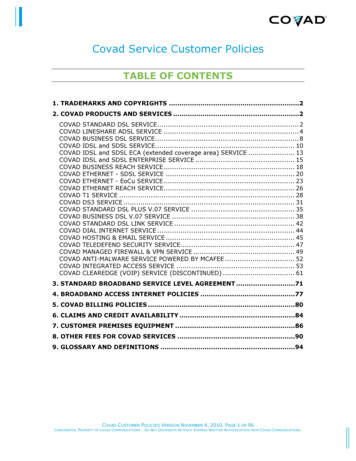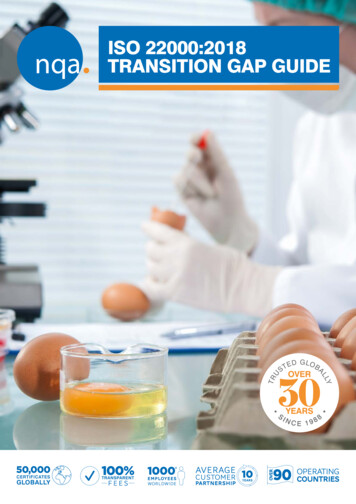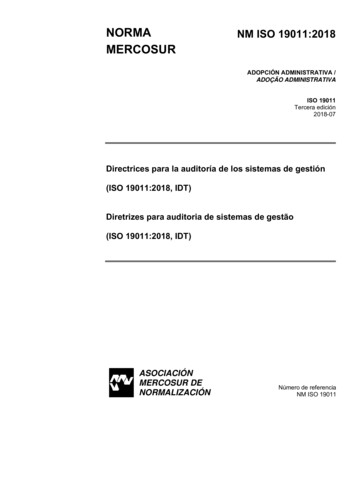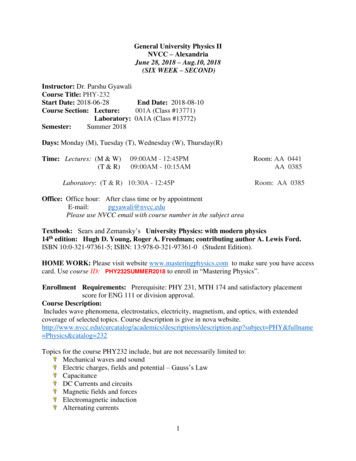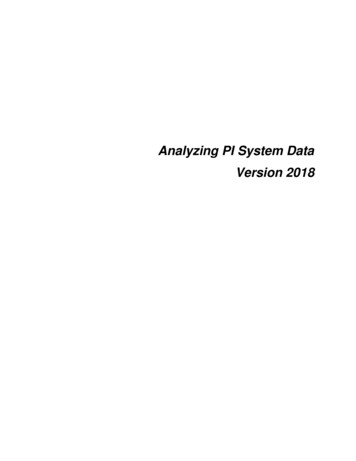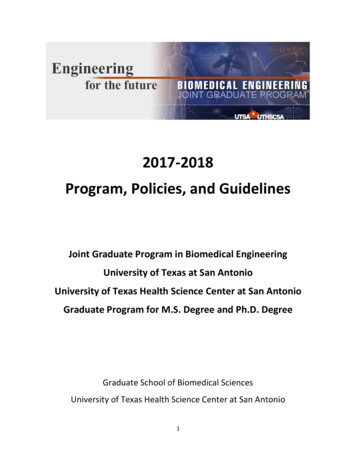
Transcription
2017-2018Program, Policies, and GuidelinesJoint Graduate Program in Biomedical EngineeringUniversity of Texas at San AntonioUniversity of Texas Health Science Center at San AntonioGraduate Program for M.S. Degree and Ph.D. DegreeGraduate School of Biomedical SciencesUniversity of Texas Health Science Center at San Antonio1
BME program policies and guidelines are in compliance with those established by the UTSystem (http://www.utsystem.edu/) Board of Regents (http://www.utsystem.edu/bor/rules/),the UT Health San Antonio (http://www.uthscsa.edu/hop2000/), and the Graduate School .uthscsa.edu/).(http://catalog.uthscsa.edu/) of UT Health San Antonio provides general information andregulations that relate to students. In the event of discrepancies between BME programpolicies/guidelines and those established by UT governing components, those described by thegoverning components will prevail.The policies of the BME Program are regularly reviewed and updated; therefore, this copy maynot be the most current.AccreditationIn 2010, UTSA completed the requirements for reaffirmation of its accreditation. The SouthernAssociation of Colleges and Schools Commission on Colleges (SACSCOC) accredits UTSA toaward bachelors, masters, and doctoral degrees. In early 2011, UTSA received official notice ofreaffirmation of accreditation from the SACSCOC President, Dr. Belle Wheelan.The UT Health San Antonio is accredited at Level VI by the Commission on Colleges of theSouthern Association of Colleges and Schools (SACS), 1866 Southern Lane, Decatur, GA 300334097, to award certificates and baccalaureate, master’s, doctoral and professional degrees. UTHealth San Antonio was most recently reviewed and fully reaffirmed by SACS in 2008. Thisaccreditation includes all programs offered at the institution and extends through 2018 with aninterim five year review completed in March 2014.The Graduate School of Biomedical Sciences is reviewed by the Texas Higher EducationCoordinating Board (THECB), 1200 E. Anderson Lane, Austin, TX 78752, on a statewide reviewschedule. The Joint Graduate Program in BME, by itself, does not undergo external review by anindividual discipline accrediting body; rather it is reviewed as part of the portfolio of doctoralprograms in the GSBS. This THECB-mandated review is in accordance with the requirements ofSACS that public institutions of higher education have a process to “review the quality andeffectiveness of existing programs and for continuous improvement.”The last external review of the Joint Graduate Program in BME was published on January 25,2016.The Joint Graduate Program was approved by the Texas Higher Education Coordinating Board inFebruary 2003, and our first batch of students matriculated in the fall 2003 semester.2
Table of ContentsAccreditation. 2Important Notes for Students Navigating Two University Settings Simultaneously . 5Disclaimer. 5Revisions . 5Program Overview . 5Summary and Outlook for the Future. 5Program Purpose . 6Brief history of program. 6The history of the Ph.D. degree in Biomedical Engineering and its relationship to UTSA’s strategic plan. 6The history of the Master of Science degree in Biomedical Engineering and its relationship to UTSA’sstrategic plan. 7Reporting/administrative structure . 7Alignment of program with institutional mission/goals . 8Program Characteristics . 9Curriculum (sequence, courses, length, etc.) . 9Requirements for admission to candidacy: M.S. Thesis Option . 14Master's Degree Requirements and Program of Study Non-thesis Option. 16Comparison of curriculum to peer programs . 17Admissions criteria . 17Ph.D. Admission Requirements and Deadlines . 17M.S. Admission Requirements and Prerequisites . 18Students and Graduates . 18Faculty . 19Faculty qualifications . 19Resources . 21Facilities and equipment . 21Financial resources. 25BME Graduate Program: Admissions . 261.Application Method . 262.Adherence to Admission Requirements . 263.Leave of Absence . 273
4.Re-Admission . 275.Student Orientation . 27BME Graduate Program: Matriculation Procedure . 271.Mentors and Home Institutions . 272.Interruption/Changed Matriculation . 283.Additional Interruption/Changed Matriculation Clarification . 294.Interruption Caveats . 295.Grading System/Academic progress . 296.Program Completion/Graduation Time Limit . 297.Graduation Criteria . 308.Program Coursework Publication (Paper and/or Online) . 30BME Graduate Program: Registration Procedure . 30BME Graduate Program: Financial Aid and Veteran Benefits Procedure . 32BME Graduate Program: Tuition and Fees Procedure. 32BME Graduate Program: International Student Procedure. 33BME Graduate Program: Intellectual Property Procedure . 35BME Graduate Program: General Procedure. 36Preface . 361.Parking . 362.Student Security and Identification . 373.Technology, Technology Support. 374.Physical Fitness, Wellness, and Recreational Activities . 385.Student Health and Counseling Services . 386.Conduct and Discipline. 397.Library Services . 408.Admissions/Recruitment Committee . 409.Curriculum Committee. 40Course Catalog . 444
Important Notes for Students Navigating Two University Settings SimultaneouslyWhile the multidisciplinary, two-campus educational partnership you have embarked upon isexciting, it can also be confusing and at times frustrating. This handbook provides a lot of theinformation you need to successfully navigate the administrative infrastructure on bothcampuses. However, it is not totally comprehensive.DisclaimerThe information contained in this handbook does not constitute a contract, expressed orimplied, between any applicant, student, or faculty member and the Joint UTSA/UT Health SanAntonio Program in Biomedical Engineering. The Joint Program in Biomedical Engineeringreserves the right to alter course offerings at any time, or change the curriculum or any otherprocedures leading to the awarding of a degree and any other requirements affecting students.Changes will become effective whenever the proper authorities so determine. The changes willapply to prospective students and may apply to those already enrolled in the Program.RevisionsRecommendations for improving the content of this handbook are welcomed from the studentsand any members of the faculty of the Joint UTSA/UT Health San Antonio Program inBiomedical Engineering.Program OverviewThe University of Texas at San Antonio (UTSA) and UT Health San Antonio jointly offer M.S. andPh.D. degrees in Biomedical Engineering (BME). The objective of the Joint Graduate Program isto train students in the use of basic biomedical engineering approaches for the investigation offundamental bioengineering questions associated with the diagnosis and treatment of humandiseases. The educational goals of this program are founded on the belief that the basicscientific and engineering approaches are critical to the fundamental understanding of humanhealth and the treatment of disease.The Joint Graduate Program is designed to build on the scientific interactions and cooperationbetween the basic science and clinical faculty at UT Health San Antonio and the engineeringand basic science faculty at UTSA. It is felt that this distinctive type of research environmentoffers the students maximum opportunity to develop into well-rounded, competitivebiomedical engineering professionals. Because engineers, scientists and clinicians participate inthe education and training of each student, graduates from this program would be uniquelytrained in the fundamental sciences and engineering related to medicine. The Joint GraduateProgram has outstanding faculty, many of whom are leaders in their respective fields, nationallyand internationally recognized.Summary and Outlook for the FutureThe Joint Graduate Program in BME has enjoyed great success. Talented and productive facultymembers from both institutions have embraced the program since its inception, and interestamong the faculty continues to grow. Collaborations between faculty members at the two5
institutions are expected to continue to develop and expand. The Joint Graduate Program hasattracted well-qualified students from not only local institutions (San Antonio and Texas), butalso institutions across the United States and internationally. More active recruitment ofstudents continues, and it is expected that the caliber of our matriculating students willincrease as a result. Both the students and faculty bring new ideas and additional energy to thedeveloping biomedical industry in San Antonio and South Texas. This Joint Graduate Programhas benefited institutions through the production of joint patents, publications, and increasedextramural research funding. The activities provided through this Joint Graduate Program haveenhanced the visibility of both institutions as the biotechnology industries continues to grow inthe city, state, and nation.Program PurposeIn line with UTSA’s and UT Health San Antonio’s strategic plans and as well as UTSA’s College ofEngineering and UT Health San Antonio’s Graduate School of Biomedical Sciences strategicplans, the goals of the program are to: Attract and retain top quality students while maintaining cultural diversity; Provide an infrastructure that enhances student success in graduation rates throughsupplemental education, advisement and mentoring; Provide curricula that serve the needs of our constituents; Facilitate meaningful internships and co-op programs that enhance the value ofclassroom education; Expose students to research as a means of enriching their learning experience andpromoting graduate education; Promote excellence in both teaching and administrative support.Brief history of programThe history of the Ph.D. degree in Biomedical Engineering and its relationship to UTSA’s strategicplanThe Joint M.S. and Ph.D. degrees in BME was approved by the THECB in 2003. This JointGraduate Program was launched as a ground-breaking program, with much collaboration andinfrastructure planning. Core faculty was appointed in early 2003, and it was determined by thecore faculty that the Ph.D. degree program will be first offered to applicants in the fall 2003semester. Core courses to be taught in the first semester were also established by the corefaculty prior to the review of the first year’s Ph.D. applications. In fall 2003, the Joint GraduateProgram admitted its first Ph.D. class of 11 students. Dually-enrolled, all students took theircourses either at the UTSA and/or the UT Health San Antonio campus. No duplicate courses areoffered at either the UTSA or the UT Health San Antonio campus, and such offerings allow our6
students the opportunity to be exposed to the many diverse educational and researchexperiences at both campuses.Without an initial department to house the Joint Graduate Program and since the UTSA catalogwas published before the approval of the program, all BME courses were initially given theMechanical Engineering (ME) prefix. This ME prefix was later changed to a BME prefix whenUTSA established its BME department in early 2006. The current UTSA graduate catalog lists theBME core courses, prescribed electives and free electives. In addition, new BME courses arecontinuously being added or modified as new faculty members are being added to the JointGraduate Program and the BME department. As such, changes to courses offered in the BMEprogram will also be reflected every two years when the new catalog is effective. All newlyadded or modified courses, program policy and information pertaining to student successes willalso be continuously updated on the Joint Graduate Program website.The history of the Master of Science degree in Biomedical Engineering and its relationship toUTSA’s strategic planApproved in 2003 by the THECB, together with the Joint Ph.D. Program in BiomedicalEngineering, the Joint M.S. Program began accepting its first batch of students in fall 2007. Ofthe eight students accepted, five of them ultimately enrolled for that semester. Like the JointPh.D. Program in Biomedical Engineering, students in the Joint M.S. Program are dually-enrolledat UTSA and UT Health San Antonio and thus allowing the students to have similar educationaland research opportunities at both institutions.Reporting/administrative structureThe Deans of the Graduate School and College of Engineering at UTSA and the Dean of theGraduate School of Biomedical Sciences at UT Health San Antonio have overall responsibilitiesfor the Joint Graduate Program in Biomedical Engineering. The graduate faculty of theBiomedical Engineering program, along with the Program Director and Associate ProgramDirector are responsible for curriculum development and ongoing missions of the program.The Program Director and Associate Program Director advise all graduate students, maintainrecords, and represent the program. The day-to-day administrative operation of the BMEProgram is the responsibility of the Program Director, Associate Director, and the Chair of theCommittee on Graduate Studies (COGS), a position held by Associate Program Director. TheCOGS advises and makes recommendations to the Program Director and Associate Director onall educational aspects of the program.The composition of the COGS for the BME Program consists of the BME program faculty.However, UTSA and UT Health San Antonio should each be represented by at least threemembers. The COGS meeting is chaired by the Associate Program Director. The ProgramDirector and Associate Program Director serve as non-voting members of COGS and can jointlycast a final deciding vote if needed. The COGS is responsible for the development andmodification of BME program policies, processes, courses, companion procedure andoperations manuals or guidelines to implement the requirements of the BME Graduate Student7
Administration Agreement. Addenda are reviewed regularly by COGS and updated by COGS asneeded.The Joint Graduate Program is supervised by a COGS that is currently composed of all BMEProgram faculty (both Core and Associated) members. These program faculty members are alsoon the Graduate Faculty at either UTSA or UT Health San Antonio or both. From this COGSmembership, subcommittee Chairs are elected to lead various programmatic activities forwhich the COGS is responsible, such as recommending student admission to the program,overseeing academic curricula, monitoring student progress in the program, and attestingeligibility for admission to candidacy for a degree. Recommendations are made by thesesubcommittees to the COGS, which then advises the Program Director and Associate ProgramDirector for implementation and/or, if warranted, seeking the Graduate Deans for finalapproval.Program direction, overview, and student success is jointly managed by the Program Directorand the Associate Program Director, who report directly to the Deans of the College ofEngineering and the Graduate School at UTSA, and the Dean of the Graduate School ofBiomedical Sciences at UT Health San Antonio. Per the MOU agreement, all three Deans solicitnominations from the BME graduate faculty for the Program Director and Associate ProgramDirector positions. The Dean of the Graduate School of Biomedical Sciences at UT Health SanAntonio and the Deans of the College of Engineering and the Graduate School at UTSA confirmand appoint the Program Director and Associate Program Director for a period of three years.Upon the expiration of terms, the Biomedical Engineering Program faculty elects a newProgram Director and Associate Director every three years. After each election, the credentialsof both newly elected Directors are forwarded to the Deans for final approval.Alignment of program with institutional mission/goalsThe UTSA is dedicated to the advancement of knowledge through research and discovery,teaching and learning, community engagement and public service. As an institution of accessand excellence, UTSA embraces multicultural traditions and serves as a center for intellectualand creative resources as well as a catalyst for socioeconomic development and thecommercialization of intellectual property for Texas, the nation and the world. To be a premierpublic research university, UTSA provides access to educational excellence and prepares citizenleaders for the global environment. An environment of dialogue and discovery is encouraged,where integrity, excellence, inclusiveness, respect, collaboration and innovation are fostered.The mission of the UT Health San Antonio is to make lives better through excellence ineducation, research, health care and community engagement. Strategies for achieving thismission include 1) educating a diverse student body to become excellent health care providersand scientists; 2) engaging in research to understand health and disease; 3) commercializingdiscoveries, as appropriate, to benefit the public; 4) providing compassionate and culturallyproficient health care; 5) engaging our community to improve health; and 6) influencingthoughtful advances in health policy. The Graduate School of Biomedical Sciences at UT HealthSan Antonio provides an individualized, diverse and multidisciplinary learning environment for8
students to develop the knowledge, skills and creativity to succeed in the evolving biomedicalspace.Faculty and Academic Equal Opportunity/Affirmative Action Office: The mission of the Facultyand Academic EO/AA Office is to insure that every member of the Health Science Center (HSC)community, individuals seeking employment or an education, and individuals who wish toparticipate in a benefit from programs and activities offered by the HSC are afforded equalopportunity and freedom from all forms of discrimination that may violate their civil rights andother protections afforded them by the State of Texas, the University of Texas System and theUT Health San Antonio.The UTSA’s Commitment: Title IX of the Education Amendments of 1972 (20 U.S.C. § 1681) is afederal law that prohibits discrimination based on gender in educational institutions whichreceive federal financial assistance. Title IX also prohibits sexual harassment, which includessexual assault and sexual violence. Please see the following cedures/studentgrievances/The UT Health San Antonio’s Commitment: The UT Health San Antonio is committed tomaintaining a learning environment that is free from discriminatory conduct based on gender.As required by Title IX, UT Health San Antonio does not discriminate on the basis of sex in itseducation programs and activities, and it encourages any student, faculty, or staff member whothinks that he or she has been subjected to sex discrimination, sexual harassment (includingsexual violence) or sexual misconduct to immediately report the incident to the Title IXDirector.Please see the following evances/Program CharacteristicsCurriculum (sequence, courses, length, etc.)As the Joint Graduate Program is multi- and inter-disciplinary, the program’s curriculum isdesigned to provide a synergistic combination of formal courses, seminars, teachingopportunities, interactions with clinicians, and individualized biomedical engineering researchexperiences in the laboratories of the BME program faculty.9
The present curriculum requires all PhD students to take 17 semester credit hours of corecourses in 1) Responsible Conduct of Patient-Oriented Clinical Research, 2) Experimental Designand Data Analysis, and 3) any four of the following courses: Biomaterials, ExperimentalBiomechanics, Bioimaging/Physics of Diagnostic Imaging, BME Engineering Analysis, orPhysiology for Bioengineers/Biology for Bioengineers. In addition, all students are also requiredto attend research seminars every semester while in the program, complete a minimum of 9semester credit hours of prescribed electives, and a minimum of 15 semester credit hours ofdoctoral research, doctoral dissertation and supervised teaching.The required and selected courses are intended to focus and support the student’s mastery of aparticular area of expertise. Throughout their graduate training, students have access to thebioengineering and biosciences laboratories at both UTSA and UT Health San Antonio. Thisprovides a unique opportunity to have learning experiences in medical, dental, bioscience, andengineering environments.Degree Requirements Ph.D.Requirements for admission to candidacy:Students seeking a doctoral degree from the Joint Ph.D. Program in BME must be admitted tocandidacy. In order to be admitted to candidacy, the student must comply with the followingrequirements: Fulfilled the requirements for unconditional admission as a Ph.D. degree-seekingstudent in the Joint Ph.D. Program in BME, which entails the removal of any conditionsassigned at the time of admission. Completed all required core courses in the Joint Ph.D. Program in BME and obtainedsatisfactory grades. Be in good standing with the Graduate School (minimum GPA of 3.0). Passed the qualifying examination as prepared by the Qualifying Exam Committee. Passed the research proposal defense and recommended for admission to candidacyby the Dissertation Research Committee. Submitted an updated program of study to the Graduate School.Had satisfied the above requirements, be approved for admission to candidacy by the Dean ofthe Graduate School.Requirements for the degree:10
The following requirements must be satisfied for graduation with a Ph.D. degree in BME: Residency Requirement: A student must spend at least two consecutive semesters (falland spring, summer Terms I and II and fall, or spring and summer Terms I and II) inresidence as a full-time student. During the residency period, the student must beregistered for a minimum of 9 semester credit hours each regular semester either atUTSA, at UT Health San Antonio, or at both institutions, and 6 semester credit hoursduring the summer semester. Grade Point Average: A cumulative grade point average of “B” (3.0 on a 4.0 scale) forcourses taken at UTSA and UT Health San Antonio must be maintained in each of thefollowing:1. Required core courses in the Joint Ph.D. Program in BME;2. All graduate elective courses; and3. Transferred grades from other institutions (other than UTSA and UT Health SanAntonio) are notused in the computation of cumulative GPA. Course Requirements: The Ph.D. program in BME consists of at least 82 semestercredit hours beyond the bachelor’s degree. Undergraduate courses, general educationcourses, and prerequisites for graduate courses are not counted toward this total.Course requirements are 17 semester credit hours of Required Core Courses, researchseminars for every semester while in the program, a minimum of 9 semester hours ofPrescribed Electives, and a minimum of 15 semester hours of Doctoral Dissertation,Doctoral Research, and Supervised Teaching. Support Work: In addition to courses and research in the field of specialization withinBiomedical Engineering, support work will be performed by students to broaden orsupplement the student’s preparation. Support work may consist of conferenceattendance, writing of abstracts and manuscripts, and presentations at nationalconferences. Additionally, as these students mature while in the program, support workcan also be in the form of student mentoring, where these students are learning tobecome a research supervisor. In many of these instances, students may be given theopportunity to mentor and supervise Master’s level and undergraduate students in theirresearch. Language Proficiency: Biomedical Engineering students are required to possess acompetent command of English
UTSA established its BME department in early 2006. The current UTSA graduate catalog lists the BME core courses, prescribed electives and free electives. In addition, new BME courses are continuously being added or modified as new faculty members are being ad





